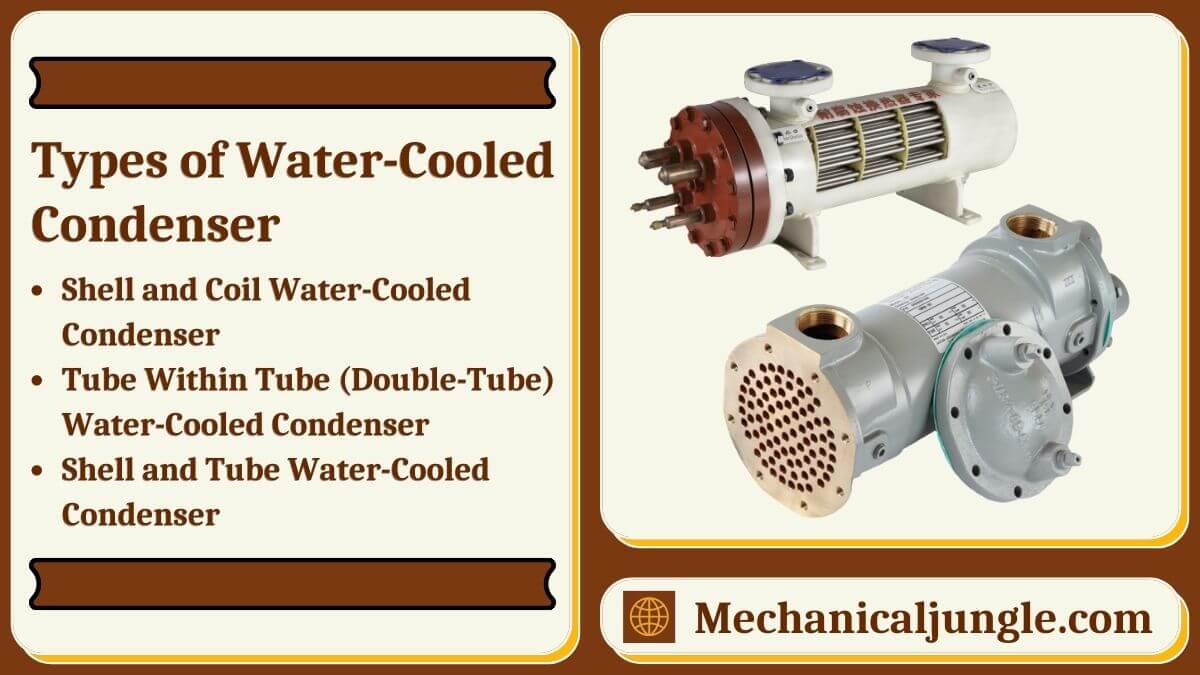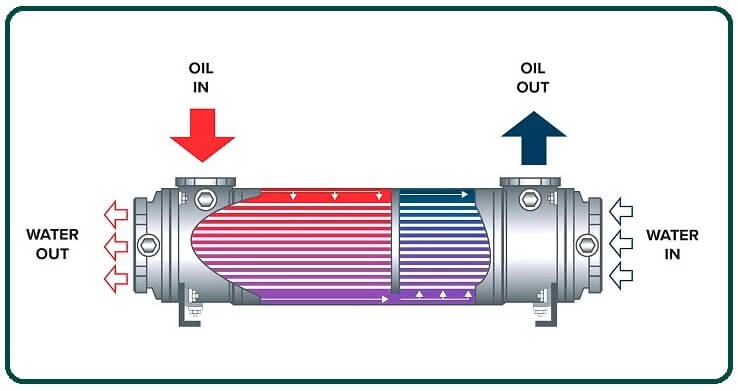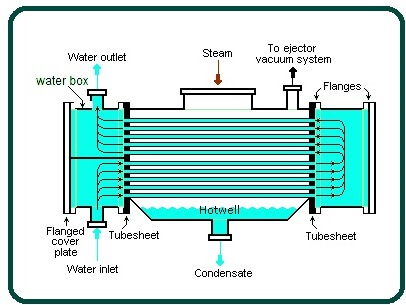Important Point
What Is a Water-Cooled Condenser?
It is a technical heat exchanger used to remove heat from the refrigerant vapor and transfer it to the water running inside the tube. Water-cooling systems have seen considerable use over the years, although they are also increasing in small businesses & some residential applications.
The system operates through networks of water coils that are used to transfer heat from the condenser coils. These systems usually work in conjunction with cooling towers to dissipate heat.
Water-cooled systems are often chosen because:
#1. They Operate at Better Efficiencies
Overall a water-cooled condenser unit will generally consume less overall energy, which can lead to savings on energy costs and consumption.
#2. Extended lifespan
Due to the efficiency of the medium and the lack of weather-exposed parts, a water-cooled system will typically last for years, assuming maintenance is not neglected.
#3. Can Operate Better at Higher Temperatures
Industries such as construction may find that water-chilled systems work more effectively in areas with higher temperatures.
How Does a Water-Cooled Condenser Work?
This type of condenser has been developed to transfer heat from the working fluid to the secondary fluid. Vapour normally enters the condenser at a temperature above the temperature of the secondary fluid.
When the vapor cools, it reaches saturation temperature, condenses into a liquid, and releases a large amount of latent heat; As a result, the vapor content decreases and the liquid volume increases; Whereas only liquid will remain at the outlet of the condenser.
Types of Water-Cooled Condenser
There are three basic types of commercials water-cooled condensers:
#1. Shell and Coil Water-Cooled Condenser
A shell condenser is a steel tank with a copper tube inserted into the shell. As water flows through tubings, it condenses the hot gases into a fluid, and the lower part of the shell receives the fluid.
Advantages of this type of separate condenser include the compact design and the elimination of fans. Since the coils are completely surrounded by steels shell, mechanical cleaning of such coils is nearly impossible.
#2. Tube Within Tube (Double-Tube) Water-Cooled Condenser
The second types of these condensers are double-tube. One tube is placed inside the other in such a way that the water flowing through the inner tube cools the refrigerant in the outer tube. This condenser can be constructed either in a cylindrical spiral or in a rectangular style.
#3. Shell and Tube Water-Cooled Condenser
Shell and tubes are the most common types of a condenser in large chemical processing plants. In this type of condenser, the number of straight water tubes is surrounded by a large cylindrical shell. The shell can be with or without fins.
Common materials for shells are steel and copper. Steels tubes are used in ammonia refrigerating systems because ammonia corrosives copper. The grooved tube sheet is welded at both ends of the cylinder. The water tubes are extended to the groove of the tube sheet to achieve a vapor-tight fit. An intermediate support is provided to avoid bending of the water hose.
The removable water box is bolted to the tube sheet. This arrangement facilitates the cleaning of the condenser in the event of contamination. The hot refrigerant enters the topmost shell. The refrigerant rejects the heat of the water when it comes into contact with the water tubes. Eventually, the condensed refrigerant sinks to the bottom of the shell.
Advantages of Water-Cooled Condenser:
- Where there is a restriction for an air-cooled condenser, a water-cooled condenser is an ideal replacement.
- The thermal energy used in other heating processes is recovery.
- This type of condenser can be placed indoors.
- A water-cooled system usually lasts for years, assuming maintenance is not neglected.
- Its heat transfer rate is high.
- It consumes very little overall energy, which can lead to savings on energy cost & consumption.
- It does not require any external power.
- Since water coolings are more efficient than air cooling, the time required for cooling is less.
- The length of the condenser pipe is reduced, thereby reducing the work of the compressor and thus increasing its efficiency.
- With the inclusion of these condensers, the net load of the system increases.
Disadvantages of Water-Cooled Condenser:
- Using water as a cooling medium can lead to corrosion problems.
- The use of water as a cooling medium can lead to a build-up of scales in the supply line.
- Due to the scarcity of freshwater around the world, few countries can afford to use wastewater.
- Using a water tank makes the system heavy, which results in problems during home use.
Frequently Asked Questions (FAQ)
Water Cooled Condensing Coil
A Water-Cooled Condenser is a heat exchanger that removes heat from refrigerant vapor and transfers it to the water running through it. Having the refrigerant vapor condensed on the outside of a tube achieves this. In doing so, the vapor condenses and gives up heat to the water running inside the tube.
Water Cool Condenser
A Water-Cooled Condenser is a heat exchanger that removes heat from refrigerant vapour and transfers it to the water running through it.
Condenser Type
Three main and different types of condensers:
- Air-cooled condenser.
- Water-cooled condenser.
- Evaporative Condenser.
Water Cooled Condenser Coils
Water-cooled condensers mainly use copper tubing to prevent corrosion and for maximum heat transfer, and, on large units, integrally finned tubing is also used to advantage. Commercial water-cooled condensers are of three basic types:
- Shell-And-Coil
- Tube-Within-A-Tube, or Double-Tube
- Shell-And-Tube Multi-Pass.
Water Cooling Condenser Coils
The shell condenser, or shell-and-coil condenser as it is commonly called, is a tank made of steel with copper tubes inserted in the shell. Water circulates through the tubing and condenses hot gases into a liquid. The bottom of the shell serves as the liquid receiver.
Air Cooled.net
Aircooled.Net is the VW parts catalog and acquisition service for people who love their air-cooled VWs and want the truth about the parts they put on their cars.
How Does Condenser Work?
A condenser is designed to transfer heat from a working fluid (e.g., water in a steam power plant) to a secondary fluid or the surrounding air. The condenser relies on the efficient heat transfer that occurs during phase changes, in this case, during the condensation of vapor into a liquid.
What Is a Condenser?
In systems involving heat transfer, a condenser is a heat exchanger used to condense a gaseous substance into a liquid state through cooling.
Chill Water Coil
Chilled water coils, also known as hydronic cooling coils, are typically used to cool or remove moisture from air streams. The air to be cooled moves through the fins, and either water or an ethylene or propylene glycol solution move through the tubes.
Like this post? Share it with your friends!
Suggested Read –
- Bolt Types
- Steam Condenser
- What Is a Synchromesh Gearbox? | Principle of Synchromesh Gearbox | Construction of Synchromesh Gearbox | Working of Synchromesh Gearbox
- Working of Constant Mesh Gearbox | What Is a Constant Mesh Gearbox? | Different Gear Ratios in Constant Mesh Gearbox | Construction of Constant Mesh Gearbox
- Difference Between Orthogonal and Oblique Cutting | Orthogonal Machining
- What Is Magneto Ignition System | How Does an Ignition System Work | How Does a Magneto Work | What Does a Magneto Do | Magneto Ignition System
- What Is Cupola Furnace? | Cupola Furnace Design । Cupola Construction | Purpose of Cupola | Working Principle of Cupola Furnace: | Advantages of Cupola Furnace | Disadvantages of Cupola Furnace | Applications of Cupola Furnace




Leave a Reply